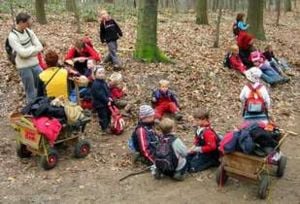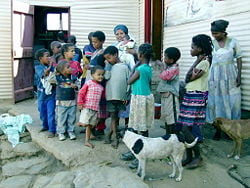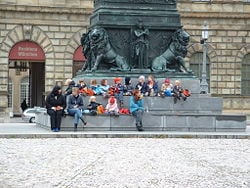Kindergarten
| Schools |
|---|
| Education |
| History of education |
| Pedagogy |
| Teaching |
| Homeschooling |
| Preschool education |
| Child care center |
| Kindergarten |
| Primary education |
| Elementary school |
| Secondary education |
| Middle school |
| Comprehensive school |
| Grammar school |
| Gymnasium |
| High school |
| Preparatory school |
| Public school |
| Tertiary education |
| College |
| Community college |
| Liberal arts college |
| University |
Kindergarten (German for Garden for Children) is used in many parts of the world for the first stages of a child's classroom education. In some places kindergarten is part of the formal school system; in others it may refer to preschool or daycare. In all cases, kindergarten functions as a transition between the home environment, primarily involving play and family based activities, to the more structured environment of a larger group of peers led by adults who are not their parents. Based on the philosophy of the German educator Friedrich Wilhelm August Fröbel, kindergarten activities, while structured, generally focus on play and creative activities teaching about nature, at the same time introducing the children to appropriate forms of interpersonal relationships in a wider social group.

History
Friedrich Wilhelm August Fröbel (1782-1852), the German educationalist, was the founder of the Kindergarten system. The son of a Lutheran pastor, Fröbel was a lonely child due to the lack of time his parents could provide for him and as a result, he formed a youthful connection with nature. This connection, along with his strong Christian faith, formed the basis of his educational philosophy. Fröbel believed that people naturally have the ability to be productive and creative, and that the fulfillment of this comes through “developing these in harmony with God and the world.” The “father of kindergarten,” he applied this philosophy to children’s education as he believed that development through free self-expression, creativity, social participation, and motor expressions formed the basis for social stability and guidance from youth into adulthood.
Play was viewed by Fröbel as a natural mode for the child’s learning, and this learning should be built upon with what he termed as "gifts" and "occupations" or "activities." The "gifts" were a series of geometric objects that were used to create structures and pictures that fell into three basic categories. These categories again reflected Fröbel’s beliefs in nature and religion: the "forms of nature or life,” “forms of knowledge or science,” and “forms of beauty or art.” The main educational purpose behind play through these “gifts” was that it would enable children to learn about the underlying concepts that were represented by the objects. Fröbel’s use of “occupations” or “activities” consisted of a series of structured activities that provided sensory experiences for children. Fröbel also maintained that children had a greater potential to learn more through role-playing than through discussions.
Prior to the establishment of Fröbel’s first kindergarten, he observed that younger children under the required age for school attendance were neglected by the educational system. This acted as a catalyst for Fröbel, as his educational beliefs where that those young children were in need of education from a preschool level in order for their natural development to proceed harmoniously. Fröbel published his first book, The Education of Man, in 1826, which chiefly dealt with the educational development of the child up to the age of seven. Fröbel later went on to open his first institution for young children in 1837, naming his new school the Play and Activity Institute. In 1840 the name of this Play and Activity Institute was changed and it became the first Kindergarten, or "Garden for Children."
By 1847 seven Kindergartens had been established in Germany, indicating that Fröbel’s practice of early childhood education was being well received. As the news of kindergartens spread throughout Germany, Fröbel saw the need to further spread his childhood educational philosophy, and began training kindergarten teachers. It was through his training that two sisters, Bertha Meyer von Ronge and Margarethe Meyer Schurz, brought the teachings of kindergartens to a more global scale. Berthe proceeded to open up new kindergartens in Germany. She later moved with her husband, the radical clergyman Johannes Ronge, to England where she embarked on a campaign to spread kindergartens throughout Europe. In 1851 Berthe, along with her husband, opened the first “England Infant Garden” in Hampstead.
Margarethe also worked at the Infant Garden before immigrating to the United States with her husband, Carl Schurz. Margarethe used Fröbel’s teachings to educate her own daughter and four other neighborhood children. Although she conducted her kindergarten teachings in German, her practices where liked by parents and she went on to open the first small scale kindergarten in Watertown, Wisconsin in 1856. A few years later in 1859, Elizabeth Peabody, after having visited with Margarethe Schurz and being impressed with her practices of Fröbel’s early childhood education, opened the first English speaking kindergarten in Boston, Massachusetts. Kindergartens continued to spread throughout the United Sates, with the first successful public kindergarten being opened in 1873 by Susan Blow in the Des Peres School in St. Louis, Missouri.
Kindergarten Activities
Kindergartens vary in length from half a day, either morning or afternoon, to a full day. Children, usually aged between three and six years, attend kindergarten and through their attendance they learn to communicate, play, and interact appropriately with other children and adults in a structured environment. For children who previously have spent most of their time at home, kindergarten may serve the purpose of training them to be apart from their parents without anxiety. Children usually develop their first friendships while they play and interact with other children on a regular basis. Kindergartens also provide the opportunity for parents, especially mothers, to go back to part-time or full-time employment.
Kindergarten activities have long incorporated the concept of play as taking the central role in children’s learning. Learning through play has been seen as providing depth in the key areas that kindergartens work to develop in children. That is, the development of physical, social, language, emotional, and other intellectual skills. Although “spontaneous play” is often encouraged and is also seen as a beneficial manner in which young children can learn, kindergartens maintain a more structured form of activities for children to learn through structured play. Teachers provide various manipulative materials and activities to motivate children to learn language and vocabulary for reading, mathematics, science, computer skills, as well as music, art, and social behaviors.
Kindergarten Systems in Various Countries
The systems of kindergartens around the world tend to be similar. The teaching methods are generally universal and the age of children is usually within the range of around three to six years old with compulsory education beginning after that. The instances in which these general procedures are dissimilar are in poorer regions of the world. Regions such as Africa, India and China face greater challenges with their endeavors to maintain kindergartens due to harsher conditions of poverty, disease, and in some instances wars which often confront the foundations of education in their countries.
Africa
Throughout the many regions of Africa, SOS Children’s Villages provide a reliable means for children’s education, which in many cases has been unable to reach greater potentials due to wars, disease, and poverty. These villages set up what are known as SOS Kindergartens, providing education for children from the ages of three to six years old. The kindergartens are co-educational and have maximum capacities of 50 to 120 children. Most of these kindergartens operate in the mornings, however there are some full-day childcare centers in more war-affected areas, or where the SOS Children’s Villages are located far from a town center. Attendance is not mandatory, and they are not part of any larger regional school system.
Australia/New Zealand
In most states and territories within Australia and New Zealand, children are enrolled in kindergartens, which are better known as preschools, between the ages of three to five. Preschools are not part of the formal school system and not mandatory to attend. Despite preschools being considered as the precursors to primary school in which compulsory education begins at age six, attendance in preschools is usually low. Kindergartens are run by the state and also privately. Financial assistance for both forms of kindergartens is provided to the state by the Office of Child-Care within the Australian Department of Social Security.
In New Zealand, kindergartens consist of the first two years of education prior to primary school for children from ages of three to five years old. Similar to Australia, kindergarten is not compulsory to attend and mandatory education begins in Primary 1 at age six.
China
In China, the equivalent term for kindergarten is you er yuan. Kindergartens are open to children between the ages of three to five and are not part of the compulsory education system. Children begin compulsory education at the age of six with their entrance into Primary 1 or Grade 1. Prior to this and kindergarten, parents have the option of taking their children to nurseries. Kindergartens are more easily available in large and medium size cities that are economically developed; however, they can also be found in lesser-developed rural areas.
France
In France, kindergartens are known as Maternelle. Children from the ages of three to five may attend, however, attendance is not mandatory. Mandatory school attendance begins at age six when children enter into their first year of primary school. The Maternelles are state run and are administered by local authorities. Parents also have the option of beginning their child’s education at the early age of two, in Pre-Maternelle classes, which are the equivalent of daycare centers.
Germany
Kindergartens (German plural Kindergärten) in Germany are not a part of the actual school system, as they are in the United States. Attendance is not mandatory, however, all children have the legal right to a place at a kindergarten. Kindergarten establishments (day-care) in Germany are open for children between three and six years of age and are often run by churches or city/town administrations. They are held in a Kita, a short form of Kindertagesstätte (children's daycare center), which may also house a Crêche (Kinderkrippe) for children between the ages of two and nine months, and/or a Hort which is a facility for older school-age children.
Hong Kong
Kindergarten education in Hong Kong is a three-year program. Children aged two years and eight months or older attend the first year of kindergarten. Kindergarten is not compulsory to attend and is not part of the formal school education. After completing the third year of kindergarten education at age five, children enter into the compulsory education system, Primary 1, of primary schools. Many kindergartens are named "English Kindergarten," emphasizing their focus is in English language education.
India
Kindergartens in India are divided into two segments, Lower Kindergarten and Upper Kindergarten. Typically, a Lower Kindergarten class would cater to children between three to four years of age, and the Upper Kindergarten would hold classes for children between four to six years of age. Kindergartens are not mandatory to attend and are therefore not part of compulsory school education.
Kindergartens are run mainly by state governments, municipal corporations and other governmental and non-governmental agencies. They aim to provide basic reading and writing skills for children and upon completion of Upper Kindergarten, the children progress to compulsory school education which begins at the age of six with Class 1 or Standard 1 of primary school. In some cases, kindergartens are considered to be a significant influence on a young child as they are often credited with compensating for environmental deprivations that some children may experience in poorer homes. Kindergartens are also often credited for providing a positive enrollment and retention standard for girls in primary schools. This occurs in some cases as the kindergartens acts as a substitute care facility for any younger siblings.
Japan
In Japan, early childhood education begins at home. There are numerous books and television shows aimed at helping mothers of preschool children to help educate their children and to "parent" more effectively. Much of the home training is devoted to teaching manners, proper social behavior, and structured play, although verbal and number skills are also popular themes. Parents are strongly committed to early childhood education and frequently enroll their children in preschools which are the equivalent of kindergartens.
Preschools are not part of the formal educational system in Japan and are therefore not mandatory for children to attend. If parents wish to send their children to preschools they can do so as early as 15 months and up to six years of age. At the age of six, children begin compulsory education with Primary 1 or Grade 1. Preschool education provides the transition from the home to formal school for most children. The preschool experience is seen as a means to help children make the adjustment to the group-oriented life of school and in turn, to life in society itself.
Preschools are predominantly staffed by young female junior college graduates and are supervised by the Ministry of Education. In addition to preschools, a well-developed system of government-supervised day-care centers, supervised by the Ministry of Labor, is also an important provider of kindergarten education. Together, these two kinds of institutions enroll well over 90 percent of all preschool age children prior to their entrance into the formal system of education of first grade. The Ministry of Education's 1990 Course of Study for Preschools, which applies to both kinds of institutions, covers such areas as human relationships, environment, language, and expression. Many native speakers of English are employed to teach this age group on a part time or full time basis, mostly without qualifications in child development or education.
Korea
In South Korea, children normally attend kindergarten between the ages of three to five. Kindergartens are not part of the formal school system, however, the Korean Ministry of Education has instituted policies in order to increase kindergarten education throughout the country. Primary 1 or Grade 1 marks the first year of compulsory education for children in Korea and this begins at age six.
Mexico
In Mexico, kindergartens are run both by the state and the private sector. They are open for children aged between three to five; however, formal and compulsory education begins at age six in Grade 1. Kindergartens teach children to understand the basics for written and oral communication. For children of indigenous ancestry, the Mexican state finances kindergartens with specific programs that have been designed for them.
Singapore
Kindergartens in Singapore provide up to three years of preschool programs for children aged three to six. The three-year program is known as "nursery," "kindergarten 1," and "kindergarten 2" and is not mandatory for children to attend. These programs however, prepare children for their first year in the compulsory educational system of primary school at age six or seven in Primary 1.
United Kingdom
In England and Wales there are part-time "playgroups" that function as what most other educational systems in the world call kindergartens. These are not mandatory to attend and are not part of the formal educational system. They are open for children from the ages of about three to five years old. Preschool daycare or nursery school, is also not part of the formal school system and is therefore not mandatory for children to attend. If parents choose to send their children to nursery school, they can do so as early as two years old. Nursery schools follow structured activities as most kindergartens do. The first year of formal and compulsory classroom education in the United Kingdom is known as Primary 1 and this begins when a child turns five years old.
United States and Canada
In the United States and Canada kindergartens are usually administered in an elementary school as part of the K-12 educational system. Children usually attend kindergarten between the ages of five and six. Kindergarten is considered the first year of formal education although children may also have the option to go to preschool or nursery school. In some states and provinces, such as Ontario and Wisconsin, there are two grades of kindergarten: junior kindergarten (JK) and senior kindergarten (SK). However, children often only attend one of the two forms of kindergarten, not both. In Ontario, for example, senior kindergarten is a requirement while junior kindergarten is optional. After kindergarten children move on to the first grade.
Kindergartens in the Future
The future of kindergartens differs in its direction in different areas of the world. In poorer countries such as India, China, and in Africa, kindergartens face challenges more in terms of resources than in its methods of teaching. Facilities for kindergartens, as also with higher levels of education in poorer countries, are more than often inadequate. Kindergartens often run at more than full capacity and in addition to this, are unable to remain in operation due to their lack of basic facilities. In many cases they are unable to attain appropriate funds from their state or local governments. Although many governments in such countries have educational budgets and funds, these funds often get tied up in bureaucracy, red tape, and in some cases even corruption. Due to these factors, kindergartens and other educational facilities often face the consequences of inappropriate facilities for their generally over full capacity programs.
The future direction of kindergartens in the United States does not appear to be focused on the content of what is being taught in the kindergartens, but rather primarily on the length of the kindergarten day for young children. As kindergartens have proven over the course of centuries their success in terms of their teaching methods with structured activities, educationalist and parents alike have now turned their attention to whether the majority of kindergartens should remain half a day in length.
Full-day kindergartens are becoming increasingly popular as they are seen as a means to help narrow the achievement gap. Other main benefits of full-day kindergartens include an easier transition into First Grade, as children are better able to adjust to the extended day of schooling. Full-day kindergarten programs also provide children the opportunity to spend more time engaged in active, child-initiated, small-group activities. It has also been observed that teachers in full-day kindergarten classrooms often feel less stressed by time constraints and may have more time to get to know the children and better meet their needs. School districts that have not yet moved to full-day kindergartens in the United States are looking for funds to extend their school day. States are offering incentives for schools districts, especially in the poorer areas, to remain open or to begin to retain longer hours.
Despite these positive aspects, there are opponents who question the reasoning for full day kindergartens. It has been widely felt that what children are doing during the kindergarten day is more important than the length of the school day itself. Work by various researchers (Gullo 1990; Olsen and Zigler 1989) has warned educators and parents to resist the pressure to include more didactic academic instruction in full day kindergarten programs. They contend that this type of instruction is inappropriate for young children. Additionally, the development and increased popularity of homeschooling, in which children do not attend schools but receive their education in the home after attaining the age of compulsory education, has made the transitional role of kindergarten from family to school unnecessary for an increasing segment of the population.
The true direction of kindergartens is as yet not determined. There are benefits both for lengthening the kindergarten day and also for keeping the day short. In other areas of the world where the length of the day is not as pertinent in terms of the future of kindergartens, other issues relating to funding and basic operational needs take priority. In many cases, the direction in which kindergartens will go depends to a large extent on educational budgets and teacher availability, not just on the benefits which young children may attain.
ReferencesISBN links support NWE through referral fees
- Cryan, J. R., R. Sheehan, J. Wiechel and I. G. Bandy. 1992. “Success outcomes of full-day kindergarten: More positive behavior and increased achievement in the years after.” Early Childhood Research Quarterly 7 (2):187-203. EJ 450 525
- Elicker, J., and S. Mathur. 1997. “What do they do all day? Comprehensive evaluation of a full-day kindergarten.” Early Childhood Research Quarterly 12( 4): 459-480. EJ 563 073
- Fusaro, J. A. 1997. “The effect of full-day kindergarten on student achievement: A meta-analysis.” Child Study Journal 27 (4): 269-277. EJ 561 697.
- Greer-Smith, S. 1990. The Effect of a Full-Day Kindergarten on the Student’s Academic Performance. Unpublished master's thesis. Dominican University, San Rafael, C.A. ED 318 570
- Gullo, D. F. 1990. “The changing family context: Implications for the development of all-day kindergarten.” Young Children 45 (4): 35-39. EJ 409 110
- Hough, D., and S. Bryde, S. 1996. '”The Effects of Full-Day Kindergarten on Student Achievement and Effect.” Paper presented at the annual conference of the American Educational Research Association, New York. ED 395 691
- Housden, T., and R. Kam. 1992. Full-Day Kindergarten: A Summary of the Research. Carmichael, CA: San Juan Unified School District. ED 345 868
- Karweit, N. 1992. “The kindergarten experience.” Educational Leadership 49 (6): 82-86. EJ 441 182
- Koopmans, M. 1991. A Study of the Longitudinal Effects of All-Day Kindergarten Attendance on Achievement. Newark, NJ: Newark Board of Education. ED 336 494
- McGill-Franzen, A. 2006. Kindergarten Literacy: Matching Assessment and Instruction in Kindergarten. New York: Scholastic.
- Morrow, L. M., D. S. Strickland, and D. G. Woo. 1998. Literacy Instruction in Half- and Whole-Day Kindergarten. Newark, DE: International Reading Association. ED 436 756
- Olsen, D., and E. Zigler. 1989. “An assessment of the all-day kindergarten movement.” Early Childhood Research Quarterly 4 (2): 167-186. EJ 394 085
- Puleo, V. T. 1988. “A review and critique of research on full-day kindergarten.” Elementary School Journal 88 (4): 427-439. EJ 367 934
- Towers, J. M. 1991. “Attitudes toward the all-day, everyday kindergarten.” Children Today 20 (1): 25-28. EJ 431 720
External Links
All links retrieved April 17, 2018.
- Fredrich Fröbel
- Friedrich Fröbel Time Line
- Friedrich Fröbel Time Line Continued
- Fröbel Web
- Bertha Meyer Ronge
- Elizabeth Peabody
- Margarethe Meyer Schurz
- Susan Elizabeth Blow
- America's Kindergarteners
- The Shifting Kindergarten Curriculum ERIC Digest.
- Readiness for Kindergarten ERIC Digest.
- Full-Day Kindergarten Programs ERIC Digest.
- Kindersite Project - Researching in to the use of technology within Kindergartens with Kindergarten appropriate Internet content
Credits
New World Encyclopedia writers and editors rewrote and completed the Wikipedia article in accordance with New World Encyclopedia standards. This article abides by terms of the Creative Commons CC-by-sa 3.0 License (CC-by-sa), which may be used and disseminated with proper attribution. Credit is due under the terms of this license that can reference both the New World Encyclopedia contributors and the selfless volunteer contributors of the Wikimedia Foundation. To cite this article click here for a list of acceptable citing formats.The history of earlier contributions by wikipedians is accessible to researchers here:
The history of this article since it was imported to New World Encyclopedia:
Note: Some restrictions may apply to use of individual images which are separately licensed.



